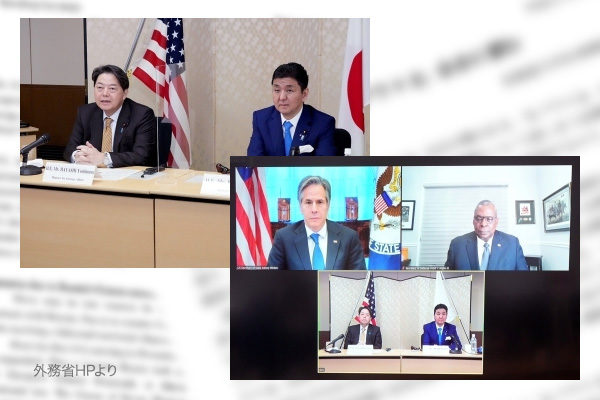On January 7, Japanese and U.S. foreign and defense ministers held their so-called two-plus-two meeting on an online basis. On January 6, Japan and Australia signed a Reciprocal Access Agreement (RAA) that facilitates their troops’ visits to each other country. I would like to consider the military significance of the two events.
Joint research on counter-hypersonic technology
After the online meeting of the Japan-U.S. Security Consultative Committee, the ministers released a joint statement calling for promoting cooperation in emerging technologies including the one to counter Chinese, Russian and North Korean hypersonic glide vehicles, or HGVs, and for deepening cooperation on space domain awareness.
In its budget proposal for fiscal 2022, the Japanese Defense Ministry has earmarked 0.3 billion yen for research on HGV detection and tracking technologies and 1.2 billion yen for research on highly sensitive infrared sensors for detecting missile firing as part of consideration to use the constellation of satellites for a missile defense system. The budget proposal also includes 6.5 billion yen for research on railguns that would use electromagnetic force to launch high velocity projectiles to intercept HGVs.
As for railguns, a news site of the Global Times affiliated with the Chinese Communist Party carried an article with photos on January 5 on the subject, indicating that China is nervous about them. Last year, however, U.S. military suspended a railgun development project.
Thus, it looks significant for the 2+2 joint statement to indicate the United States’ intention to participate in the research and development by the Japanese Defense Ministry.
The joint statement also noted the Japanese and U.S. determination to align security policy, deepen defense cooperation across all domains, and bolster extended deterrence by consulting on alliance roles, missions and capabilities. That means the U.S.’ plan to deploy intermediate-range ballistic missiles under its Pacific Deterrence Initiative and Japan’s plan to extend anti-ship missile ranges will be coordinated with each other.
Japan and Australia moving closer to an alliance
Meanwhile, cooperation between the Japanese Self-Defense Forces and the Australian defense force had been previously limited to the level of the Acquisition and Cross-Servicing Agreement (ACSA) to provide supplies and services to each other. The new Japan-Australia RAA establishes procedures between Japan and Australia for their troops’ visits to each other country and defines a legal status of visiting troops. It is comparable to the Japan-U.S. Status-of-Forces Agreement applied to the U.S. forces in Japan. Australia became the second country to sign this kind of agreement with Japan after the U.S., Japan’s one and only treaty ally.
When F/A-18 fighters of the Australian Air Force visited the Japanese Air Self-Defense Force’s Chitose base in 2019, Japan and Australia lacked any agreement on Australian troops’ entry into and departure from Japan, taxation on materials acquired and used by them, their driving licenses and weapon transportation, and how to handle their off-duty incidents and accidents. This kind of inconvenience has now been solved by the signing of the RAA.
The agreement also established a joint committee as a means for mutual consultations. It would be useful for cases similar to recent cluster outbreaks of novel coronavirus at U.S. military bases in Japan.
The accord to allow smooth deployment of large Japanese or Australian forces in each other country brings the two countries closer to an alliance. It will also contribute to their preparation for a Taiwan crisis.
Fumio Ota is a councilor and a Planning Committee member at the Japan Institute for National Fundamentals. He is a retired Vice Admiral of Japan’s Maritime Self-Defense Force.


